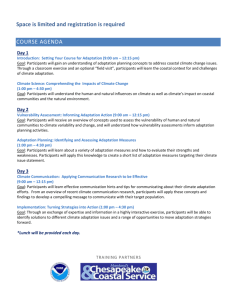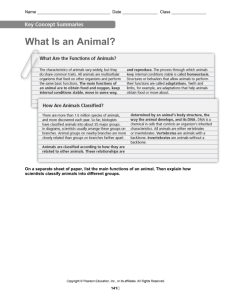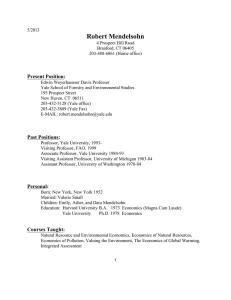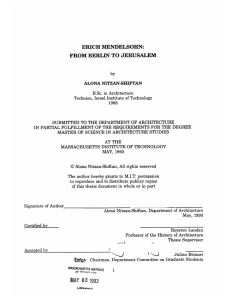- UNDP-ALM
advertisement
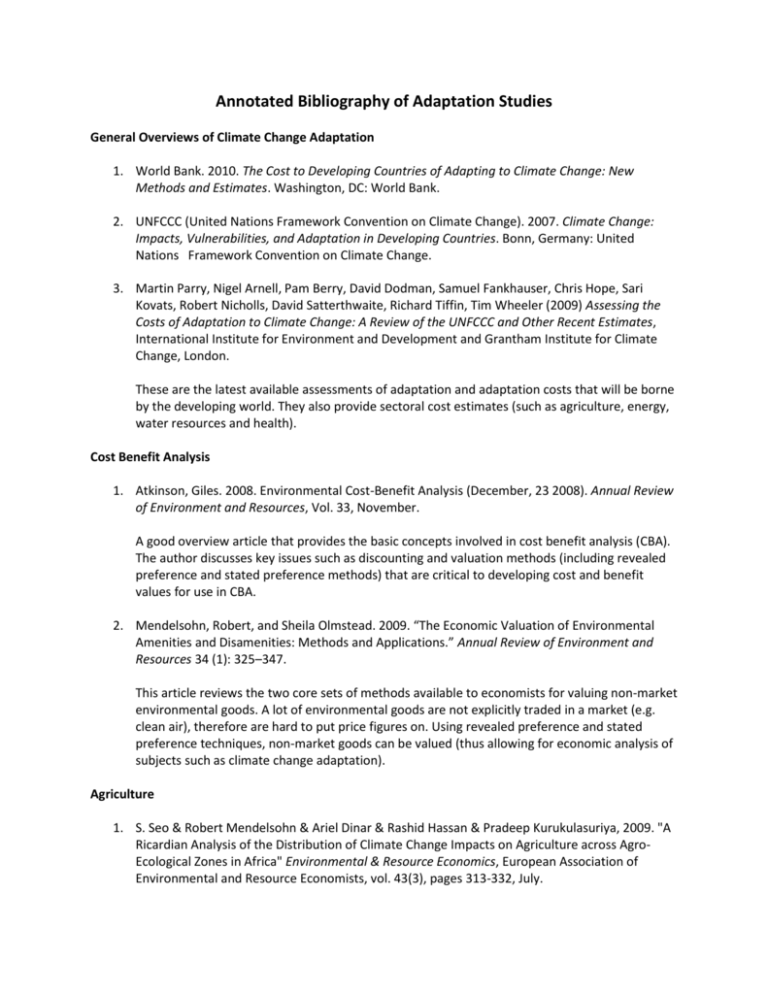
Annotated Bibliography of Adaptation Studies General Overviews of Climate Change Adaptation 1. World Bank. 2010. The Cost to Developing Countries of Adapting to Climate Change: New Methods and Estimates. Washington, DC: World Bank. 2. UNFCCC (United Nations Framework Convention on Climate Change). 2007. Climate Change: Impacts, Vulnerabilities, and Adaptation in Developing Countries. Bonn, Germany: United Nations Framework Convention on Climate Change. 3. Martin Parry, Nigel Arnell, Pam Berry, David Dodman, Samuel Fankhauser, Chris Hope, Sari Kovats, Robert Nicholls, David Satterthwaite, Richard Tiffin, Tim Wheeler (2009) Assessing the Costs of Adaptation to Climate Change: A Review of the UNFCCC and Other Recent Estimates, International Institute for Environment and Development and Grantham Institute for Climate Change, London. These are the latest available assessments of adaptation and adaptation costs that will be borne by the developing world. They also provide sectoral cost estimates (such as agriculture, energy, water resources and health). Cost Benefit Analysis 1. Atkinson, Giles. 2008. Environmental Cost-Benefit Analysis (December, 23 2008). Annual Review of Environment and Resources, Vol. 33, November. A good overview article that provides the basic concepts involved in cost benefit analysis (CBA). The author discusses key issues such as discounting and valuation methods (including revealed preference and stated preference methods) that are critical to developing cost and benefit values for use in CBA. 2. Mendelsohn, Robert, and Sheila Olmstead. 2009. “The Economic Valuation of Environmental Amenities and Disamenities: Methods and Applications.” Annual Review of Environment and Resources 34 (1): 325–347. This article reviews the two core sets of methods available to economists for valuing non-market environmental goods. A lot of environmental goods are not explicitly traded in a market (e.g. clean air), therefore are hard to put price figures on. Using revealed preference and stated preference techniques, non-market goods can be valued (thus allowing for economic analysis of subjects such as climate change adaptation). Agriculture 1. S. Seo & Robert Mendelsohn & Ariel Dinar & Rashid Hassan & Pradeep Kurukulasuriya, 2009. "A Ricardian Analysis of the Distribution of Climate Change Impacts on Agriculture across AgroEcological Zones in Africa" Environmental & Resource Economics, European Association of Environmental and Resource Economists, vol. 43(3), pages 313-332, July. A recent application of the Ricardian technique originally developed by Mendelsohn, Nordhaus and Shaw (1994). Net revenue per hectare of cropland is regressed on a set of climate, soil, and socio-economic variables. Their key finding is that with a mild climate scenario, African farmers gain income from climate change; with a more severe scenario, they lose income. They find that there is heterogeneity in the impacts of climate, where some farmers may actually become better off with a changed climate while others may lose out. 2. Kurukulasuriya, P. and Mendelsohn, R. (2009) How will climate change shift Agro-Ecological Zones and impact African Agriculture, World Bank Policy Research Working Papers Series, Washington Another recent example of the application of the Ricardian technique to determine adaptations to climate change. The authors add more structure to the analysis than in the original Ricardian studies by considering agro-ecological zones. They find that African agriculture tends to suffer with even mild climate change. 3. [Need agro economic model] Forestry 1. Sedjo, Roger and Brent Sohngen. 1998. Impacts of Climate Changeon Forests. RFF Climate Issue Brief #9. Resources for the Future: Washington, D.C. 2. Sohngen, Brent, and Robert Mendelsohn. 1998. “Valuing the Impact of Large-Scale Ecological Change in a Market: The Effect of Climate Change on U.S. Timber.” The American Economic Review 88 (4): 686–710. 3. Sohngen, Brent, Robert Mendelsohn, and Roger Sedjo. 2001. “A Global Model of Climate Change Impacts on Timber Markets.” Journal of Agricultural and Resource Economics 26 (2) (December 1): 326–343. The above references provide some of the major works on climate change impacts on the forestry sector. Sedjo and Sohngen (1998), though dated, provides a clear and brief overview of climate change impacts on forests. The paper studies forest damages from climate change. The authors conclude that the effects of climate change on forests are likely to be positive. They also “conclude that effects of climate change on ecological values associated with forests are a source of concern in specific places but need not be large overall, especially if climate change is relatively gradual and adaptation to climate change is enhanced”. Water 1. Hurd, B.H., M. Callaway, J. Smith and P. Kirshen, 2004: Climatic change and US water resources: from modeled watershed impacts to national estimates. J. Am. Water Resour. As., 40, 129-148. The most recent application of economic analysis to climate change impacts on water resources. The authors start by characterizing climate change scenarios which are then used to model changes to hydrology. These modelled hydrologic changes are fed into river-basin level spatial equilibrium models that allocate water to maximize efficiency. In their assessment, climate change affects agricultural users considerably more than other sectors. By tweaking institutional arrangements they can vary the impacts of climate change on various water using sectors. 2. Bates, B.C., Z.W. Kundzewicz, S. Wu and J.P. Palutikof, Eds., 2008: Climate Change and Water. Technical Paper of the Intergovernmental Panel on Climate Change, IPCC Secretariat, Geneva, 210 pp. This IPCC technical paper provides a good overview of climate change impacts (not adaptation) on freshwater resources. It is useful in informing adaptation policy as it lays out the context and changes that are likely for freshwater resources. 3. Madani, Kaveh, and Jay Lund. 2010. “Estimated Impacts of Climate Warming on California’s High-elevation Hydropower.” Climatic Change 102 (3). The authors study how climate change might affect optimal operations of hydro power plants in California using EBHOM (Energy-based, Hydropower Optimization Model). The model maximizes net revenues from electricity sales rather than electricity generation. Results show that by adapting management practices it is possible to increase net revenues with respect to the base case if rainfall increases. If rainfall decreases, revenues decrease as well. Storage capacity limits constraint the increase of net revenues for the wet scenario. This is an interesting finding that highlights the need for adaptations also in case of positive impacts. Storage is able to reduce the negative impact of a dry scenario. Energy 1. Ebinger, Jane, Walter Vergara, and Irene Leino. 2011. Climate Impacts on Energy Systems: Key Issues for Energy Sector Adaptation. World Bank Publications. This report provides an up-to-date compendium of what is known about weather variability and projected climate trends and their impacts on energy service provision and demand. It discusses emerging practices and tools for managing these impacts and integrating climate considerations into planning processes and operational practices in an environment of uncertainty. It focuses on energy sector adaptation, rather than mitigation which is not discussed in this report. 2. Mideksa, Torben K., and Steffen Kallbekken. 2010. “The Impact of Climate Change on the Electricity Market: A Review.” Energy Policy 38 (7) (July). 3. Mansur, Erin T., Robert Mendelsohn, and Wendy Morrison. 2008. “Climate Change Adaptation: A Study of Fuel Choice and Consumption in the US Energy Sector.” Journal of Environmental Economics and Management 55 (2) (March): 175–193. The above studies provide a sense for the kinds of adaptations required in the energy sector e.g. changes in the levels of heating and cooling needed or the mix/choices of fuels used. Coastal Sea-Level Rise 1. Nicholls, R. J, S. Hanson, C. Herweijer, N. Patmore, Stephane Hallegatte, J. Corfee-Morlot, Jean Chateau, and Robert Muir-Wood. 2008. Ranking Port Cities with High Exposure and Vulnerability to Climate Extremes: Exposure Estimates. OECD Environment Working Paper. OECD Publishing. http://econpapers.repec.org/paper/oecenvaaa/1-en.htm. 2. Nicholls, R.J., S.P. Leatherman, K.C. Dennis, and C.R. Volonté. 1995. “Impacts and Responses to Sea-Level Rise: Qualitative and Quantitative Assessments.” Journal of Coastal Research (April 1): 26–43. 3. Nicholls, Robert J., Natasha Marinova, Jason A. Lowe, Sally Brown, Pier Vellinga, Diogo de Gusmão, Jochen Hinkel, and Richard S. J. Tol. 2011. “Sea-level Rise and Its Possible Impacts Given a ‘beyond 4°C World’ in the Twenty-first Century.” Philosophical Transactions of the Royal Society A: Mathematical, Physical and Engineering Sciences 369 (1934) (January 13): 161–181. These works provide a good sense for climate change impacts on coastal infrastructure. For instance, Nicholls et al. (2011) provide a good example of a study that assesses alternative adaptation options to protect global coastal land. The study starts by assuming a sea-level rise of 0.5m-2m in 2100, consistent with a high warming scenario. The study then uses DIVA (Dynamic and Interactive Vulnerability Assessment): an integrated model of coastal systems that assesses biophysical and socioeconomic impacts driven by climate change and socioeconomic development. Health 1. Deschênes, Olivier, and Michael Greenstone. 2011. "Climate Change, Mortality, and Adaptation: Evidence from Annual Fluctuations in Weather in the US."American Economic Journal: Applied Economics, 3(4): 152–85. The authors estimate the temperature‐mortality response function estimated from daily temperature and annual county‐level mortality data for the U.S. between 1968 and 2002. One extra day with temperature than 32°C or lower than 4°C with respect to the long-term average temperature increases the annual mortality rate by 0.1%. The sensitivity to warming is higher for people above 65 years of age, for low-income people or people what were already sick. 2. Bell, Michelle, Richard Goldberg, Christian Hogrefe, Patrick Kinney, Kim Knowlton, Barry Lynn, Joyce Rosenthal, Cynthia Rosenzweig, and Jonathan Patz. 2007. “Climate Change, Ambient Ozone, and Health in 50 US Cities.” Climatic Change 82 (1): 61–76. This study is a good example of an assessment of impacts from and adaptation to climaterelated pollution health stresses. The authors first estimate the relationship between current climate and current ozone concentrations in 50 US cities. They then use GCM scenarios to predict future climate in 2050 and see how the concentration of ozone might change, keeping all the emissions of all particulates and substances that lead to the formation of ozone fixed. The impact of higher ozone concentrations on human health is assessed using estimated concentration-response (or dose-response) functions from the literature. Cyclones and Hurricanes 1. Mendelsohn, Robert, Kerry Emanuel, Shun Chonabayashi, and Laura Bakkensen. 2012. “The Impact of Climate Change on Global Tropical Cyclone Damage.” Nature Climate Change 2 (3) (January 15): 205–209. The authors use a tropical cyclones model generator to estimate the potential impact of climate change on several countries. They project changes in population and in assets that will be potentially exposed to the force of the cyclone. They find that damages become extremely large for a few huge tropical cyclones of truly catastrophic potential. However, these events are so rare that it is unclear what the optimal policy response should be. Aggregate Assessment 1. Bosello, Francesco, Roberto Roson, and Richard Tol. 2007. “Economy-wide Estimates of the Implications of Climate Change: Sea Level Rise.” Environmental and Resource Economics 37 (3): 549–571. The authors assess economy wide impacts of climate and possible adaptation. They start by developing a baseline scenario for the world economy in 2050. They use projections from other models or assumptions on economic growth, population, resources availability and other relevant variables. In the baseline scenario they assume that climate change has no impact on the economy. They then create a scenario in which sea-level rise reduces coastal land. They do not include explicit protections like sea-walls, but they let markets work to re-allocate land between sectors. For example, agricultural land lost along the coastline can be replaced by agricultural land subtracted to other uses in the interior. 2. Döll, Sebastian (2009) : Climate change impacts in computable general equilibrium models: An overview, HWWI Research Paper, No. 1-26. Even though this is a research working paper, it provides an excellent overview of CGE modelling and climate change. The author goes through a range of issues that crop up in CGE modelling of climate impacts. He also provides an overview and insight son adaptation studies using CGE modelling techniques.





